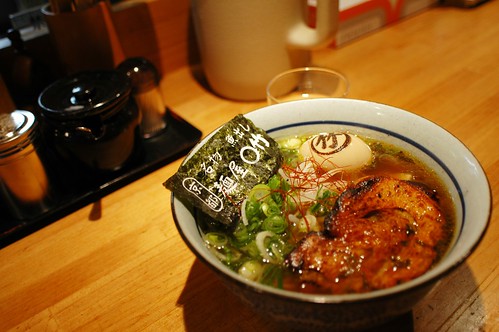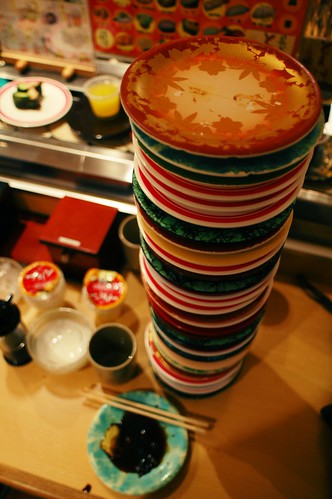I know it's pretty bold of me to be saying I know the best place to eat takoyaki in the city that invented the dish, but I'm confident enough in my opinion that I'm willing to make such a claim. But wait a second-- some of you people who live outside Japan may not be up to speed on what exactly takoyaki is.
Well, please allow me to explain.

Takoyaki is made of a wheat flour mixture roughly analogous to pancake batter that is grilled in a special takoyaki cast-iron pan lined with half-spherical molds. Once in the pan, the batter is filled with chunks of octopus and turned as they cook using long sticks to form balls about 3-5cm in diameter. It's typically eaten as a snack, either using chopsticks or toothpicks to fork the balls into one's mouth. It is usually ordered by the half-dozen, and averages about $3-5 for that quantity.

Takoyaki has been famous in Osaka and the surrounding Kansai area since the early 1930's. It took a couple years for them to settle on what exactly to put inside the gooey dough, with false starts using beef and egg before they eventually hit upon the idea of octopus.
Since then it has spread in popularity outside the Kansai region and can now also be found all over Japan. Varieties can even be found in neighboring Asian countries such as South Korea, China, and Taiwan. However the best takoyaki is still without a doubt found in the city of Osaka itself, with the best damn takoyaki in Osaka to be found in a little shop in Juso that I'm about to introduce to you.
Being the birthplace of takoyaki, Osaka has a takoyaki shop on almost every street corner, all of them meeting fierce competition from their neighboring rivals. And when festivals bring larger crowds of people into town, plenty more vendors spring forth to meet the additional demand with portable takoyaki grills fitted to the back of small covered trucks or inside mobile stalls.
There's a saying that every family in Osaka also owns its own
personal electric takoyaki grill, and since you can pick one up in most department stores for a little more than $10 I wouldn't be surprised if this were the truth.
The popularity of takoyaki in Osaka and the sheer volume in which it is consumed in the city and the surrounding region has led this part of Japan to be far and away the world' s largest consumer of octopus.

These days there are many additional little secrets added to the wheat flour mix to improve the tastiness and consistency of the takoyaki, from various spices to baking powder, pickled ginger (
benishouga 紅生姜), tempura scraps (
tenkasu 天かす), and so on.
There's also a special takoyaki sauce (initial research indicates possible ingredients include okonomiyaki sauce, chicken broth, tomato puree, mango puree, soy sauce and tobasco sauce, but don't quote me on any of that!) for pouring over top, and there are a few other more conventional sauces that are also usually offered, such as soy sauce and citrus-flavored Ponzu sauce. You are also given your choice of an array of toppings, from sliced green onion, and dried shredded seaweed (
aonori 青のり), to mayonnaise, and dried bonito shavings (
katsuobushi 鰹節)

True-blue Osaka takoyaki has a very special mixture of textures, crispy on the outside from the grill, yet still soft and moist and not-fully-cooked on the inside. This consistency keeps its temperature for quite some time, perfect for those getting it to go and wanting the takoyaki still warm by the time they get home. Unfortunately this piping-hot temperature has also been the source of many a scalded tongue and roof-of-mouth for those too impatient to wait. Joe's word of advice: while your takoyaki cools walk over to the nearest convenience store and pick up a can of beer to enjoy with your snack. You'll thank me for it, as the combination is flawless.

Ok, now you should all have a better idea what I'm talking about, so let's get back to what I was saying.
The best damn takoyaki in Osaka can be found in Juso, one of the oldest entertainment and red light districts in the two thousand year old city I call home. There are classier places for night life in the city (and dirtier), but something about Juso's raw life, energy, and, I'll admit it, sleaziness, appeals to me as, dare I say it, an honest expression of natural human vice. Here is a typical scene in the red light district of Sakaemachi in Juso, a street lined with strip shows, massage parlors, girls' bars (bars waitressed and tended by scantily-clad girls), and "free information" booths beckoning Japanese businessmen to learn where the naughtier places are tactfully hidden in the surrounding alleyways:

This is actually pretty quiet for Juso, since I got there around 8pm, before the place really gets rocking.
A block away from this scene, in the opposite direction of the gaudy castle spires and neon lights of the love hotels, hidden in a side-street that connects the bad part of Juso to a more respectable albeit decaying shopping arcade, is the takoyaki stand in question. The stand sits laid-back and unassuming, nestled between a fortune teller's storefront plastered with photos of the psychic smiling with B-list celebrities on one end and a silent dry cleaning shop on the other. The steel shutters of the dry cleaner clatter shut long before the rest of Juso wakes up for a night of sin.
 View Larger Map
View Larger MapKaritoro Takoyaki
Juso Honmachi 1 Chome 20-20
Yodogawa-ku, Osaka City
Phone: 06-6885-8898
カリトロ 十三本町本店
大阪府大阪市淀川区十三本町1丁目20−20
The name of the shop describes the unique taste sensation that defines well-made takoyaki,
karitto meaning crisp and crunchy, and
torori meaning soft and sticky.
To achieve extra crispiness on the outside Karitoro Takoyaki adds lots of extra tempura scraps. To make it extra creamy and soft on the inside, they add their own secret broth mixed with milk to the batter. They also have an ingredient true to the original takoyaki recipe but not often included in the modern variant:
Konjac gelatin (
konnyaku こんにゃく). There's not much taste added by the Konjac, but the texture serves as a nice complement to the rest of the takoyaki.
The more I write about Japanese cuisine the more you will see how important texture (
shokkan 食感) is to food here. So important that it has its own word, while the English translation has to share its meaning with things you touch with your fingers.
I'll leave you with one last photo of Karitori's takoyaki in its anatomical view:

Truth be told takoyaki isn't for everyone, but if you ever visit Osaka you'd be a fool not to at least give it a try. Especially at the best damn place in town.
Osaka readers, think you know somewhere better? Leave me a message with the name and address of the takoyaki shop, and I promise I'll give it a try! And hey, if I like the place a lot, I'll be sure to include it in this blog.^^














































